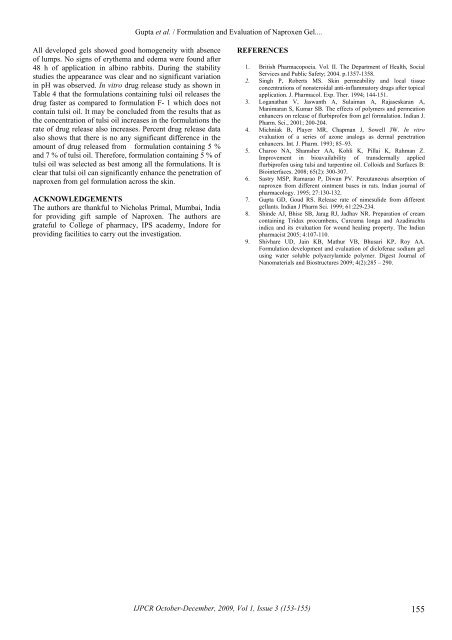Create successful ePaper yourself
Turn your PDF publications into a flip-book with our unique Google optimized e-Paper software.
All developed gels showed good homogeneity with absence<br />
of lumps. No signs of erythema and edema were found after<br />
48 h of application in albino rabbits. During the stability<br />
studies the appearance was clear and no significant variation<br />
in pH was observed. In vitro drug release study as shown in<br />
Table 4 that the formulations containing tulsi oil releases the<br />
drug faster as <strong>com</strong>pared to formulation F- 1 which does not<br />
contain tulsi oil. It may be concluded from the results that as<br />
the concentration of tulsi oil increases in the formulations the<br />
rate of drug release also increases. Percent drug release data<br />
also shows that there is no any significant difference in the<br />
amount of drug released from formulation containing 5 %<br />
and 7 % of tulsi oil. Therefore, formulation containing 5 % of<br />
tulsi oil was selected as best among all the formulations. It is<br />
clear that tulsi oil can significantly enhance the penetration of<br />
naproxen from gel formulation across the skin.<br />
ACKNOWLEDGEMENTS<br />
The authors are thankful to Nicholas Primal, Mumbai, India<br />
for providing gift sample of Naproxen. The authors are<br />
grateful to College of pharmacy, IPS academy, Indore for<br />
providing facilities to carry out the investigation.<br />
Gupta et al. / Formulation and Evaluation of Naproxen Gel....<br />
REFERENCES<br />
1. British Pharmacopoeia. Vol. II. The Department of Health, Social<br />
Services and Public Safety; 2004. p.1357-1358.<br />
2. Singh P, Roberts MS. Skin permeability and local tissue<br />
concentrations of nonsteroidal anti-inflammatory drugs after topical<br />
application. J. Pharmacol. Exp. Ther. 1994; 144-151.<br />
3. Loganathan V, Jaswanth A, Sulaiman A, Rajaseskaran A,<br />
Manimaran S, Kumar SB. The effects of polymers and permeation<br />
enhancers on release of flurbiprofen from gel formulation. Indian J.<br />
Pharm. Sci., 2001; 200-204.<br />
4. Michniak B, Player MR, Chapman J, Sowell JW. In vitro<br />
evaluation of a series of azone analogs as dermal penetration<br />
enhancers. Int. J. Pharm. 1993; 85–93.<br />
5. Charoo NA, Shamsher AA, Kohli K, Pillai K, Rahman Z.<br />
Improvement in bioavailability of transdermally applied<br />
flurbiprofen using tulsi and turpentine oil. Colloids and Surfaces B:<br />
Biointerfaces. 2008; 65(2): 300-307.<br />
6. Sastry MSP, Ramarao P, Diwan PV. Percutaneous absorption of<br />
naproxen from different ointment bases in rats. Indian journal of<br />
pharmacology. 1995; 27:130-132.<br />
7. Gupta GD, Goud RS. Release rate of nimesulide from different<br />
gellants. Indian J Pharm Sci. 1999; 61:229-234.<br />
8. Shinde AJ, Bhise SB, Jarag RJ, Jadhav NR. Preparation of cream<br />
containing Tridax procumbens, Curcuma longa and Azadirachta<br />
indica and its evaluation for wound healing property. The Indian<br />
pharmacist 2005; 4:107-110.<br />
9. Shivhare UD, Jain KB, Mathur VB, Bhusari KP, Roy AA.<br />
Formulation development and evaluation of diclofenac sodium gel<br />
using water soluble polyacrylamide polymer. Digest Journal of<br />
Nanomaterials and Biostructures 2009; 4(2):285 – 290.<br />
IJPCR October-December, 2009, Vol 1, Issue 3 (153-155) 155


